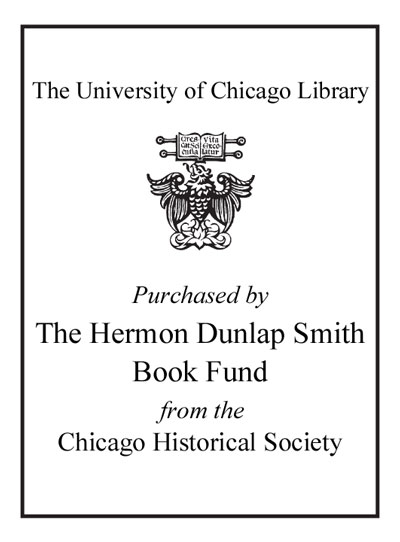How the West was drawn : mapping, Indians, and the construction of the trans-Mississippi West /
Saved in:
| Author / Creator: | Bernstein, David, 1973- author. |
|---|---|
| Imprint: | Lincoln : University of Nebraska Press, [2018] |
| Description: | xvi, 303 pages : illustrations, maps ; 24 cm. |
| Language: | English |
| Series: | Borderlands and transcultural studies Borderlands and transcultural studies. |
| Subject: | |
| Format: | Print Book |
| URL for this record: | http://pi.lib.uchicago.edu/1001/cat/bib/11660816 |
MARC
| LEADER | 00000pam a2200000 i 4500 | ||
|---|---|---|---|
| 001 | 11660816 | ||
| 005 | 20180726144055.4 | ||
| 008 | 180105s2018 nbuab b s001 0 eng | ||
| 003 | ICU | ||
| 010 | |a 2017052576 | ||
| 035 | |a (OCoLC)1009214270 | ||
| 040 | |a DLC |b eng |e rda |c DLC |d OCLCO |d OCLCQ |d OCLCO |d OCLCF |d NBL |d NhCcYBP | ||
| 020 | |a 9780803249301 |q hardcover ; |q alkaline paper | ||
| 020 | |a 0803249306 |q hardcover ; |q alkaline paper | ||
| 020 | |z 9781496207999 |q electronic book | ||
| 020 | |z 9781496208002 |q electronic book | ||
| 020 | |z 9781496208019 |q electronic book | ||
| 042 | |a pcc | ||
| 043 | |a np----- | ||
| 050 | 0 | 0 | |a E98.C17 |b B47 2018 |
| 082 | 0 | 0 | |a 978.004/97 |2 23 |
| 086 | |a U5002 T475 .0009 -2018 |2 nbdocs | ||
| 100 | 1 | |a Bernstein, David, |d 1973- |e author. |0 http://id.loc.gov/authorities/names/n2018001158 |1 http://viaf.org/viaf/29151594440805351820 | |
| 245 | 1 | 0 | |a How the West was drawn : |b mapping, Indians, and the construction of the trans-Mississippi West / |c David Bernstein. |
| 264 | 1 | |a Lincoln : |b University of Nebraska Press, |c [2018] | |
| 300 | |a xvi, 303 pages : |b illustrations, maps ; |c 24 cm. | ||
| 336 | |a text |b txt |2 rdacontent |0 http://id.loc.gov/vocabulary/contentTypes/txt | ||
| 337 | |a unmediated |b n |2 rdamedia |0 http://id.loc.gov/vocabulary/mediaTypes/n | ||
| 338 | |a volume |b nc |2 rdacarrier |0 http://id.loc.gov/vocabulary/carriers/nc | ||
| 490 | 1 | |a Borderlands and transcultural studies | |
| 504 | |a Includes bibliographical references and index. | ||
| 505 | 0 | |a Living in Indian country -- Construction Indian country -- Sharitarish and the possibility of treaties -- Nonparticipatory mapping -- The rise and fall of "Indian country" -- The cultural construction of "Indian country" -- Science and the destruction of "Indian country" -- Reclaiming Indian country -- The metaphysics of Indian naming -- Conclusion. | |
| 520 | |a "How the West Was Drawn explores the geographic and historical experiences of the Pawnees, the Iowas, and the Lakotas during the European and American contest for imperial control of the Great Plains during the eighteenth and nineteenth centuries. David Bernstein argues that the American West was a collaborative construction between Native peoples and Euro-American empires that developed cartographic processes and culturally specific maps, which in turn reflected encounter and conflict between settler states and indigenous peoples. Bernstein explores the cartographic creation of the Trans-Mississippi West through an interdisciplinary methodology in geography and history. He shows how the Pawnees and the Iowas -- wedged between powerful Osages, Sioux, the horse- and captive-rich Comanche Empire, French fur traders, Spanish merchants, and American Indian agents and explorers -- devised strategies of survivance and diplomacy to retain autonomy during this era. The Pawnees and the Iowas developed a strategy of cartographic resistance to predations by both Euro-American imperial powers and strong indigenous empires, navigating the volatile and rapidly changing world of the Great Plains by brokering their spatial and territorial knowledge either to stronger indigenous nations or to much weaker and conquerable American and European powers. How the West Was Drawn is a revisionist and interdisciplinary understanding of the global imperial contest for North America's Great Plains that illuminates in fine detail the strategies of survival of the Pawnees, the Iowas, and the Lakotas amid accommodation to predatory Euro-American and Native empires" -- provided by the publisher. | ||
| 650 | 0 | |a Indians of North America |z Great Plains |v Maps. | |
| 650 | 0 | |a Cartography |z Great Plains |x History |y 19th century. | |
| 651 | 0 | |a Great Plains |v Maps. | |
| 650 | 0 | |a Names, Indian |z Great Plains. | |
| 650 | 7 | |a Cartography. |2 fast |0 (OCoLC)fst00848025 | |
| 650 | 7 | |a Indians of North America. |2 fast |0 (OCoLC)fst00969633 | |
| 650 | 7 | |a Names, Indian. |2 fast |0 (OCoLC)fst01032444 | |
| 651 | 7 | |a Great Plains. |2 fast |0 (OCoLC)fst01240567 | |
| 648 | 7 | |a 1800-1899 |2 fast | |
| 655 | 7 | |a History. |2 fast |0 (OCoLC)fst01411628 | |
| 655 | 7 | |a Maps. |2 fast |0 (OCoLC)fst01423704 | |
| 830 | 0 | |a Borderlands and transcultural studies. |0 http://id.loc.gov/authorities/names/no2012076633 | |
| 903 | |a HeVa | ||
| 929 | |a cat | ||
| 999 | f | f | |i f2831a35-f7bf-5d56-9517-c48624921b9c |s ec7b9ca4-50d1-5c32-a6ec-e1a020854aa9 |
| 928 | |t Library of Congress classification |a E98.C17 B47 2018 |l JRL |c JRL-Gen |i 11072035 | ||
| 927 | |t Library of Congress classification |a E98.C17 B47 2018 |l JRL |c JRL-Gen |e hesm |b 114557418 |i 9987173 | ||

